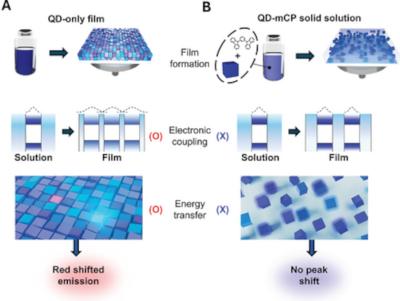Metal halide perovskite light-emitting diodes (PeLEDs) that emit deep-blue color with high efficiency have not yet been fully achieved and become more difficult in the thin film of confined perovskite colloidal quantum dots (PeQDs) due to particle interaction. Recently, researchers from Seoul National University and University of Toronto demonstrated that electronic coupling and energy transfer in PeQDs induce redshift in the emission by PeQD film, and consequently hinder deep-blue emission.
Scheme illustrating QD-QD interaction related to emission spectrum shifts in the A) QD-only film and B) QD-mCP solid solution. Image credit: Advanced Materials
To achieve deep-blue emission by avoiding electronic coupling and energy transfer, a QD-in-organic solid solution was introduced, to physically separate the QDs in the film. This physical separation of QDs reduces the interaction between them yielding a blueshift of ≈7 nm in the emission spectrum.
Moreover, using a hole-transporting organic molecule with a deep-lying highest occupied molecular orbital (≈6.0 eV) as the organic matrix, the formation of exciplex emission is suppressed. As a result, an unprecedently high maximum external quantum efficiency of 6.2% at 462 nm from QD-in-organic solid solution film in PeLEDs was achieved, which satisfies the deep-blue color coordinates of CIEy < 0.06.
This recent work demonstrated an important material strategy to deepen blue emission without reducing the particle size to <≈4 nm.


